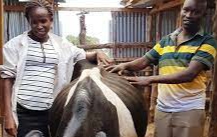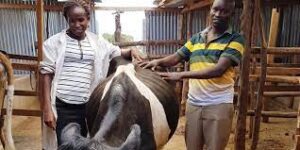Bomet Couple Reaps Big from their Monumental Zero-Grazing Project
Dairy farming has gained them a respectable status in their community, and everybody admires their cooperation.


Peter and Fancy Ng’eno are not a typical couple. They are used to trying something different to capitalize on possibilities.
Full of determination, they ventured into dairy farming and established monumental zero-grazing units in an area dominated by an open grazing system.
A Modest Beginning
When the couple kept their cows on the family’s farms in a tiny settlement near Bomet, Kenya, they barely produced enough milk for personal consumption, let alone for sale. During dry seasons, when cows were deprived of forage, the situation deteriorated.
This explains why fodder is crucial in dairy production since it accounts for 70% of the dairy cow feed needs, while feed additives account for the remaining 30%. A lack of feed leads to poor cow health, low milk output, low fertility, and illness susceptibility.
Optimal Yield
The pair learned the value of optimal animal nutrition and its major influence on milk yield with the help of Feed the Future’s Kenya Agricultural Value Chains Enterprises (KAVES), which provided extension services in conjunction with the county department of agriculture.
“We used to feed our cows to fill their tummies, but today we know they require nutritional feed that is finely cut up for the convenience of feeding and contains both green and dry materials.”
By cultivating our fodder at home in Chebole, we save money on feed.
“I harvest and deliver it to town for my cows,” Peter Ng’eno explained.
Fame and Status
The couple astounded the neighbourhood by cultivating grass rather than maize.
They have no regrets, though, because milk production rose by 5 litres per cow in a year, and they currently gather 25 litres per cow each day.
“Dairy farming has gained me a respectable status in this community, and everyone knows me as the dairy guy,” Ng’eno proudly proclaims. “Selling in town brings in more money at KES 45 per litre, up from KES 25 to 30 at home.” During the dry season, I am currently selling a litre for KES 70, which is a fantastic business.”
His wife Fancy emphasizes how they take care of their cows as a team effort.
“We’ve been upgrading the zero-grazing units for the cows’ comfort; they have beds to sleep on, it’s well-lit and clean, and we even play music for the cows during milking to boost milk let down.” We tried AI, and we set up a separate calf enclosure.”
Conclusion
KAVES has been working with farmers over the last four years to boost fodder establishment, conservation, and commercialization, and there is now a rising interest in commercial fodder farming as individual farmers, farmer groups, and investors notice this crucial gap.
As a consequence, 36,320 acres of fodder and pasture have been developed, and 60 hay gathering sites have been built or rebuilt, with over 800,000 bales of hay traded.
Source: Fintrac



